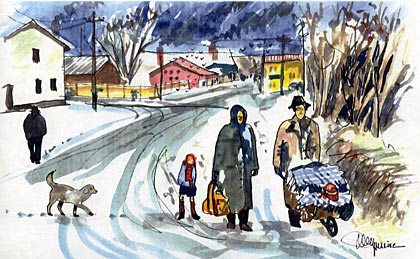Survival in WWII, 1933–1944 · Alfred Moritz (alias Mauricet)
![]() aving survived what came to be known as the "Shoah," I went about living my life and but rarely gave a thought to the events of those traumatic years. In 1994, an "ethnic cleansing" took place in the Balkans; a newspaper published a photograph of a Serb—or was it a Croat, or a Kosovar or an Albanian?—pushing a wheelbarrow with his meager belongings through a snow-covered landscape, with a mangy half-frozen dog in the distance.
aving survived what came to be known as the "Shoah," I went about living my life and but rarely gave a thought to the events of those traumatic years. In 1994, an "ethnic cleansing" took place in the Balkans; a newspaper published a photograph of a Serb—or was it a Croat, or a Kosovar or an Albanian?—pushing a wheelbarrow with his meager belongings through a snow-covered landscape, with a mangy half-frozen dog in the distance.
I felt a shock.
The scene took me back over half a century, to a time when my parents, looking for an abode, were forced to push my nine-year old brother Ernst through just such a snowy landscape as he was too ill and weak to walk. They resembled this poor man because, just as he, they had committed the unpardonable crime of being different. Now, father of two children, I realized myself what a terrible ordeal these poor people endured.
A picture being worth a thousand words, I sketched the scene from the newpaper; after all these years, my brother vaguely remembered the barrow but had the mangy dog etched clearly in his memory.

1941. Hard war winter. Looking for an abode.
That very scene triggered many recollections and I proceeded to the various waystations of our family's calvary in order to record places and events—"Kristallnacht," the Night of Broken Glass, Dachau, the 1940 Exodus, Les Milles, Theresienstadt, Le Masgelier, the Cévennes Mountain range.